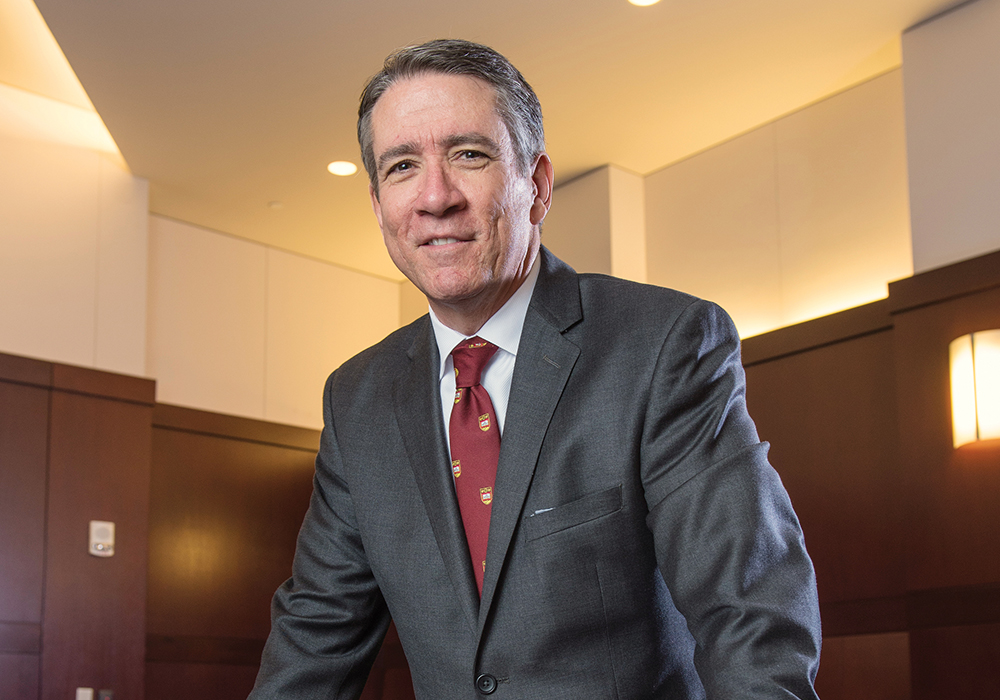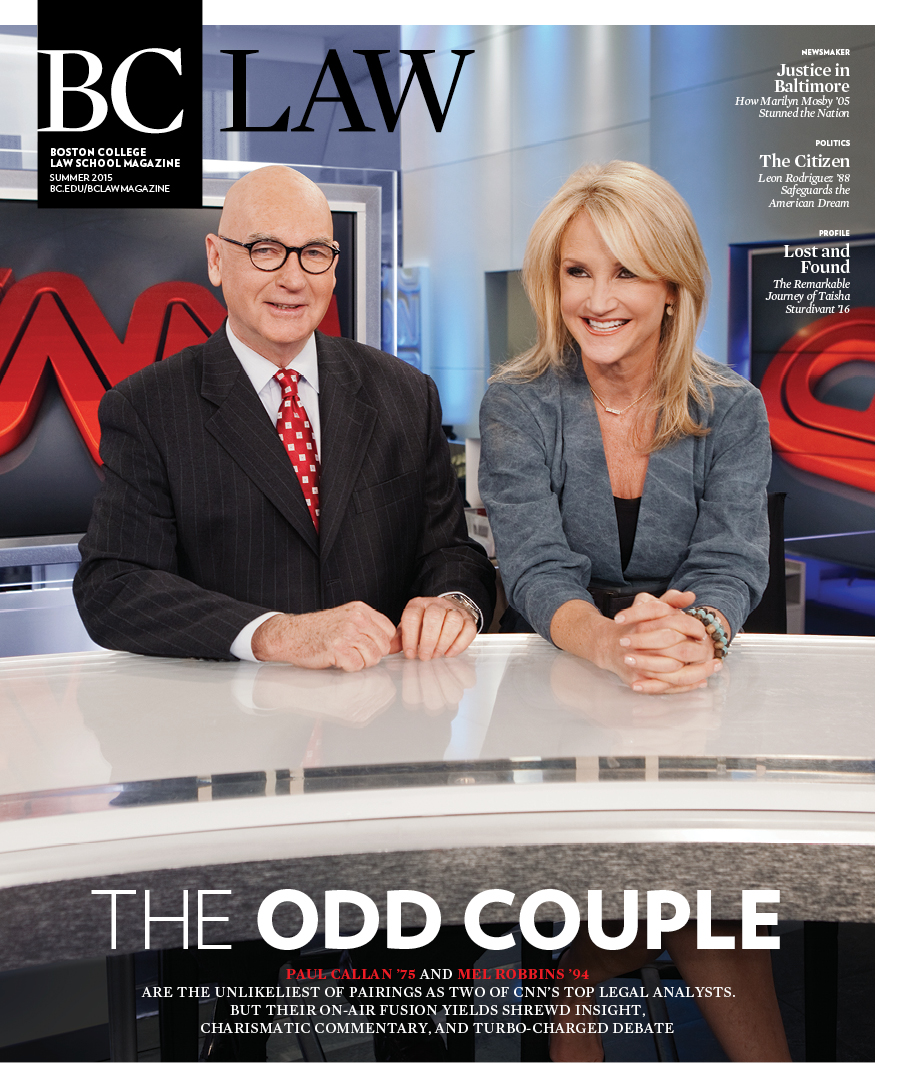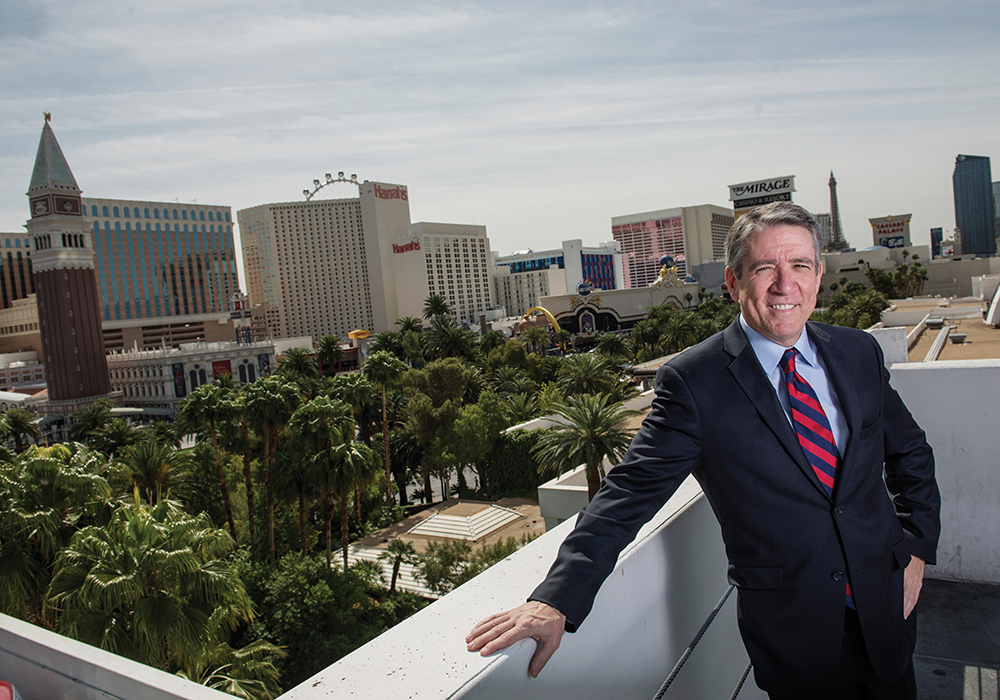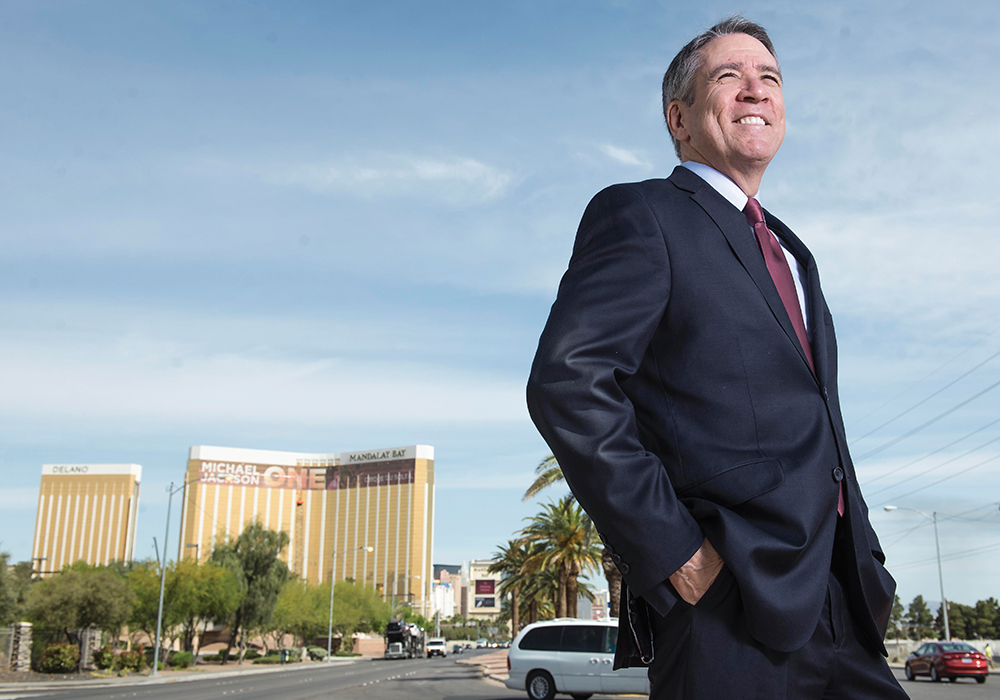When the verdict came in, in spring of 2010, Las Vegas attorney Daniel F. Polsenberg ’82 was waiting to board a plane at McCarran Airport to attend a conference. The news was reporting that a jury had awarded plaintiffs $5 million in damages against drug manufacturers, including the Israeli-based company, Teva Pharmaceutical Industries. This wasn’t his case, but Polsenberg intuited that it was about to be. He called his law partner and said, “I don’t think I should go.” In Polsenberg’s telling, his partner replied, “Don’t be so full of yourself. The world doesn’t revolve around you. Go to the conference.”
Days later, the jury awarded punitive damages. A shocking $500 million—likely the largest such award in Nevada history. “That’s when I got a call,” Polsenberg says.
Polsenberg was being realistic, not immodest, in assuming that he’d get pulled into this case. Consider his résumé. An appellate lawyer in Nevada for more than thirty years, he has argued more than 250 appeals in matters ranging from family law to products liability to taxes, has written briefs in hundreds more, and has been counsel in more than 150 reported decisions of the Nevada Supreme Court. He is a fellow of the American Academy of Appellate Lawyers—the first attorney in Nevada so honored. When Nevadans need an appellate lawyer, Polsenberg is at the top of the A-list.
The Teva verdict was a very large tip of a gigantic iceberg of civil litigation arising from a 2007 outbreak of hepatitis C in the city of Las Vegas. At the center of the outbreak was a medical scandal that saw a doctor and a nurse sent to prison on murder charges. Dr. Dipak Desai, owner of the Endoscopy Center of Southern Nevada and other clinics, and nurse anesthetist Ronald Lakeman had been double-dipping syringes into bottles of propofol, an anesthetic, and injecting the contents of the contaminated bottles into multiple patients. More than 100 patients were eventually found to be infected with hepatitis C, a virus that can lead to fatal liver disease. At least two have died. State and federal health officials issued advisories to tens of thousands of patients; Polsenberg himself went and got tested. People who were infected at the clinic, or were at risk of contracting hepatitis C or other blood-borne diseases because of their associations with the clinic, now faced a lifetime of medical monitoring, economic hardship, possible or actual illness, and pain and suffering. They started filing civil suits. They sought proof of liability and damages against various actors, including health maintenance organizations and pharmaceutical companies like Teva.
Polsenberg worked on the defense side of several of the civil cases. This was arguably the largest legal challenge Polsenberg had encountered in his career. Multiple lawyers and law firms were in on the act. “I’m used to having big cases with lots of trials and lots of plaintiffs,” Polsenberg says. “This surpassed even that.” The cases raised legal issues novel to the State of Nevada and yielded several reported opinions by the Nevada Supreme Court.
“I had to lean heavily on my extensive background and experience to keep up with the legal and procedural complexities of this case,” Polsenberg says. “It was like playing 3-D chess where all the chess pieces have machetes.”
That first suit—the one that ended in a jury awarding half-a-billion dollars in damages—went after Teva as a generic maker of the propofol used in the endoscopy clinics. Henry Chanin, sixty-two, had contracted hepatitis C at Desai’s clinic and sued the pharmaceutical company on the grounds that 1) the propofol vials did not contain sufficient warnings against reuse, and 2) the size of the vials—50-milliliters—were essentially an invitation to clinicians to reuse the anesthetic rather than “wastefully” throw the vials away after one use. Teva’s share of the half-a-billion dollar punitive damages award amounted to $356 million.
Lawsuits by other plaintiffs began piling up. Polsenberg recalls that three of them ended in verdicts in the hundreds of millions of dollars, and one trial was starting when—spoiler alert—a master settlement was reached in February 2012. The Nevada Supreme Court at one point counted as many as 200 civil actions filed with the trial courts in connection with the hepatitis C outbreak. (According to Polsenberg, it wasn’t possible to bring all plaintiffs into a single class-action because each plaintiff’s case raised unique issues of causation and damages.) The various cases were before various judges, and legal issues common to each trial were being decided in different ways. Polsenberg worked on appeals of these disparate rulings.
“This was my best experience ever working with teams of lawyers,” Polsenberg says. “Everybody was so good at what they were doing. The dynamic was fantastic. People would play off of each other’s ideas. We had great conversations.”
The sheer number of potential civil suits threatened to overwhelm Nevada’s judicial system. The Nevada Supreme Court couldn’t rely on the research and reasoning of an appellate division below it because Nevada didn’t even have a court of appeals until January of 2015, after a ballot referendum passed and the state became forty-first to have an intermediate appellate body. As verdicts were appealed and additional trials entered the pipeline, the Nevada Supreme Court took interim appeals of trial judges’ rulings and stayed the trials pending its decisions. That allowed the court to issue “course corrections”—that is, to clarify legal issues that were likely to come up again and again in these cases. “I think it was obvious to everybody that certain rulings had to be taken care of before more cases were tried,” Polsenberg says.
As issues were resolved in the middle of trials, the trials themselves would morph in new directions. “Things would change both the way we were defending the case and the way the plaintiffs were prosecuting the case in each trial,” Polsenberg says. “It was always evolving. That is highly unusual.”
One of those changes happened because of the Supreme Court—not of Nevada, but of the United States. During the Chanin trial, the plaintiffs wanted to hold Teva to state law failure-to-warn labeling standards. Teva argued that state and federal laws were in conflict regarding requirements for warning labels for generic drugs, and that federal law trumped state law under principles of federal preemption. While the Chanin case was on appeal, the US Supreme Court decided Pliva v. Mensing (2011). The court ruled that generic drug manufacturers cannot legally change their warning labels without FDA approval, and so cannot be held to state-law failure-to-warn standards.
“Mensing was decided after the Chanin trial, but it is an issue that we had raised before trial, so it would apply on appeal, possibly—probably—resulting in a complete reversal and dismissal of that case,” Polsenberg explains. “Plaintiffs had to concoct a new theory for the trials after Chanin to get around the federal preemption issue.”
The interim rulings gave the lawyers a run for their money. “Here we were, changing things on the fly, between trials, from one trial to the next, and going up on appeal in the middle of cases to get directions for future trials because we wouldn’t get the first direct appeal heard in time,” Polsenberg says. “The rulings on the first trial were just absolutely amazing. Basic principles of pharmaceutical liability, like the learned intermediary rule, where you rely on the doctor to weigh the risks and benefits—even that principle was being challenged.
“I think it was clear to the Nevada Supreme Court that these cases could be a real drag on the system, not just in terms of incorrect results, but—[what] if we tried 116 plaintiffs and then had to try them all over again? With the amount of judicial resources being devoted to these cases, we would snap our small and delicate system,” Polsenberg says. “I’m really impressed that the [Nevada Supreme] Court stepped in.”
A significant issue on appeal was whether a pharmaceutical company whose name was at all connected with the hepatitis C outbreak could get a fair and impartial jury in Las Vegas. The story was everywhere: on television, radio, the internet. Sixty thousand Nevadans had received letters from health officials warning that they might have been exposed to hepatitis and HIV. There were criminal investigations and bankruptcy proceedings. Two hundred civil actions had been filed. Dr. Desai was a hated household name. The people of Las Vegas were very, very angry.

“I’ve seen this phenomenon before,” Polsenberg says. “I’ve seen it in medical malpractice cases where the jury will get very angry at a situation but only have one particular defendant in the court room. The only way to vent the anger is to return the verdict against that defendant.” Teva’s lawyers fought to move the trials from Clark County to Washoe County, where the jury pool had not been inundated with so much adverse publicity. Polsenberg felt that not even the most diligent jury selection process or the most exquisite voir dire questioning could guarantee an impartial jury in Clark County.
The Nevada Supreme Court disagreed and ruled against a change of venue in Sicor, Inc., v. Hutchison (2011). Interestingly, the controlling precedent in Sicor was National Collegiate Athletic Association v. Tarkanian (1997), a case Polsenberg had argued before the Nevada Supreme Court more than a decade earlier as counsel for Jerry Tarkanian. Tarkanian, a college athletic coach, had sued the NCAA for wrongful termination, and the NCAA sought a change of venue from Clark County on the grounds that pretrial publicity had tainted the jury pool. Polsenberg won that one.
The Nevada Supreme Court relied on the analysis established in Tarkanian to reach its ruling in Sicor. The court combed through the record looking for evidence related to the size of the community, the nature and gravity of the lawsuit, the nature and extent of the pretrial publicity, the time between the publicity and the trial, potential jurors’ familiarity with the publicity, effect of the publicity on potential jurors, care used and difficulty in selecting a jury, and the status of the parties and political overtones. Taken together, the court ruled, “The record evidence demonstrated that, although this case and the related cases received a fair amount of pretrial publicity, some of which was viewed by potential jurors, it was not of a kind or to the extent that it tainted the jury pool, leading to a reasonable belief that appellants could not receive a fair trial in Clark County.”
Another issue that made new law in Nevada involved the admissibility of expert testimony. Once again, Polsenberg had encountered a related issue in an earlier case he himself had handled. That case, Mosicato v. Sav-On Drug Stores (2005), involved a medication that was improperly labeled. The case turned on whether the medicine was the cause of the plaintiffs’ injuries. The question was, must the defendants’ expert witness testify to a reasonable degree of scientific probability that the cause of the harm was something other than what the plaintiffs were claiming? Yes, ruled the Nevada Supreme Court. Polsenberg for the defense had argued hard against that ruling. He faced it again on behalf of his client Teva in Williams v. Eighth Judicial District Court (2011).
As part of their defense in the Williams trial, the pharmaceutical companies had a nurse and a doctor testify that it may not have been double-dipping into vials of propofol that caused the plaintiffs’ hepatitis C infections, but rather dirty scopes that had been improperly cleaned by clinic personnel. The doctor and nurse could not, however, point to any particular piece of equipment as the culprit. The Nevada Supreme Court ruled that, in general, nurses can testify as experts on medical causation, provided they have the credentials to do so. The nurse-expert in this case lacked those credentials, the court said, but he did have the credentials to offer expert testimony on the proper handling of endoscopy equipment.
On the issue of medical causation, the court made some refinements to its ruling in Mosicato. Once plaintiffs have met their burden of proof in establishing the medical cause of their injuries, the court said, the defendants can rebut the plaintiffs’ claims in three ways: 1) by cross-examining the plaintiffs’ expert; 2) by contradicting the plaintiffs’ expert with their own expert; or 3) by offering an alternative theory of medical causation. The court said that when defendants are employing tactic number three, the alternative theory offered by their expert must have a “reasonable degree of medical probability” (be more likely than not). But if defendants are employing tactic number two, the court said, “the defense expert does not need to state each additional cause to a greater than 50 percent probability.”
In the end, the Nevada Supreme Court never got to the merits of the plaintiffs’ claims against Teva. “Chanin was set to go to oral argument and the plaintiffs asked for a settlement confer ence, at which all the cases settled,” Polsenberg says. The terms of the settlement are confidential. But the Las Vegas Review-Journal reported in February 2012 that Teva settled 120 lawsuits for $285 million, leaving only fifteen unsettled lawsuits against Teva. Before settling, Teva was at risk for nearly $800 million in compensatory and punitive damages from the first three trials that went to verdict.
BC Law Professor Dean M. Hashimoto, an expert in law, medicine, and health care policy, and director of the Law School’s JD/MPH dual degree program, can’t comment on the specifics of the settlement, which are closed to the public, but he can comment more generally about why cases like this frequently end with the parties settling out of court. He notes that in the Teva litigation, several trials ended in multi-million dollar verdicts. That provided the parties with important information.
“From Teva’s end, it’s certainly in its interest to try to settle the case as soon as it has a reasonable sense as to the value of the cases just to put this issue behind it,” Hashimoto says. “And from the plaintiffs’ standpoint, it works out as well; they don’t have to suffer the litigation costs.” The courts also had an interest in the parties settling. “The court system would be supportive of settlements, given the amount of litigation time that was potentially involved, so there could very well have been pressure from that end,” Hashimoto says.
One way to look at cases like this is to think of the legal system as treating pharmaceutical companies whose products are connected to patients’ injuries as, to some extent, insurers. “In these drug cases, which don’t require a finding of fault—it’s a strict liability system—it is a matter of imposing costs from a policy perspective,” Hashimoto says. “[The companies] will continue to manufacture the drugs in association with medical treatments as long as, basically, the costs of these so-called accidents are less than the benefits.”
“It’s the idea of including the negative impacts as being part of the costs of business, then letting the manufacturer decide whether it’s worthwhile to still go forward in that particular business line,” Hashimoto explains.
Jeri Zeder is a Boston-area freelance writer. She can be reached at jzblcaw@rede.zpato.net.





